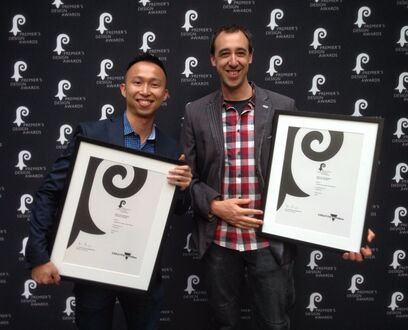‘The best approach to this is to envision a user building a relationship with your organisation.’
— Lacey Kruger, Principal Information Architect, Blackbaud.
We don’t have to tell the non-profit sector that the funding environment is highly competitive. If you’re in it, you’ll know that maintaining and building human and financial support is challenging. To help, we’ve pulled apart and put together the nitty gritty of how to get your audience to take action, again and again. Learn how to enhance engagement and build organisational effectiveness, supported by the best, real examples we could find on the Australian web.
From donations to getting your audience involved, here are our 5 ways to help boost your non-profit’s online effectiveness.
1. Encourage exploration and engagement
In order to attract new donors, you need to offer them an opportunity to get to know you. Typically, people won’t donate at first sight, especially if they’re unfamiliar with you and what you do. They’ll want to start with learning some basic facts and history, and read how your organisation makes an impact (UX Magazine). Only after that is when they’ll start looking to see how they can get involved online – such as social sharing and signing up to your newsletter. So the key is to engage them, give them the opportunities to explore and learn about your organisation and its cause, in hope that they make it all the way through the funnel to donate or take a more hands-on approach and volunteer.
Using video to engage

Oxfam understands the necessity of building relationships with their donors. Taking a very visual and emotive approach, they use animated images and video to build an emotional connection with their audience. The intention here is to inspire empathy for others’ living situations to drive us to help to improve them.
Creating interactive experiences

The Fred Hollows Foundation takes engagement a step further, using interactivity that places the user literally in the eyes of someone less fortunate. Their recent appeal invites users to experience what it’s like to have impaired vision. As we know, experiencing something yourself is radically different from simply reading about it.
Personal storytelling

Storytelling is at the heart of the Starlight Children’s Foundation’s online experience. They let children’s real, lived experiences highlight just how much impact their organisation has. Plus, control is placed in the hands of the user as they are offered content filters allowing them a “choose your own adventure” journey through the site. This includes providing no dead-ends. At the end of each story’s page, related content is promoted so users can continue reading about the same topic.
2. Pull on some heart strings
The best way to really engage with your users is to emotionally bond with them. Pull on some heart strings and evoke real feelings. Generally, as a non-profit, you want your visitors to feel emotions of high arousal. Low arousal emotions are simply happiness and sadness. Which although strong, often leave people feeling content, not fired up the way feelings such as awe, excitement, anger and humour do (Media Cause). So when creating content, ask yourself for each image: What do I feel when I look at this image? What do I want any visitor to feel when looking at this image? And does the image portrayed match this emotion?
Leveraging light-hearted humour

When Baptist World Aid Australia posted this image of a man with a goat, they successfully leveraged humour, even if it was subtle. Of course in Western society, receiving a goat as a gift would be more bizarre than life-changing, yet in developing countries, this kind of gift has a whole different value. Just remember, it’s all about nuance. Humour should have an air of light-heartedness to it – that touches hearts more than farce.
Using anger to inspire action

Instead of simply making people sad about an issue, make them a little angry. Anger drives action while sadness doesn’t. This pig caged behind bars is sad, but doesn’t it make you a little angry too... angry enough to try to get involved and help free him and animals like him? RSPCA NSW’s photography style is all about evoking feelings of actionable anger.
Excitement helps motivate

Starlight Children’s Foundation used images that told more of a story than simply a happy ending. The above example shows teamwork, achievement and celebration. Because as great as sharing content that makes people happy is, sharing content that gets people excited is even better. Happiness is a low-arousal emotion, whereas excitement evokes a high-arousal response.
3. Make important information easy to find
Loop11 conducted a competitive benchmarking study, analysing UNICEF and Red Cross’s websites, to find out what factors contribute to positive user experiences and therefore, a higher likelihood to donate online. As part of their findings, the following four-points were found to be the most important information that users wanted to find, thus, influencing their next action:
- Accurate information and facts about the appeal.
- Where the money goes.
- Financial accountability including transparency of admin and staff costs.
- Secure online payment options such as PayPal.
At a glance, these seem obvious, however in Yump’s own research, we were surprised that on many well-known Australian non-profit websites, there’s a lack of transparency about where donor’s money goes. We don’t like to name and shame so instead, here are some good user experience examples:
Display of accurate information and facts

UNICEF let hard facts and numbers do the talking in their appeal, asking users to “help UNICEF save lives”. Quoting key statistics upfront means the user doesn’t have to work hard to find accurate information about the crisis in Syria, or do any further research off their site to find out why they should support such a humanitarian cause.
Personalised content offerings

CanTeen understands what is most important to the user – control. Upon any landing, they let users self-qualify as a certain type of visitor, whether that’s a parent, a professional, a supporter or a person in need. This means their user experience is personal, and any further information they are fed, is relevant to their audience type.
Transparency and financial accountability

We admire UNICEF again, as they were actually the only ones we came across who provided a direct link to their Annual Report from their appeals pages. Not only visible, but with beautiful and simple visuals that communicate where donor’s money goes.
Secure payment options

As we know, 45% of credit card fraud takes place online, so online security (and visibility of it) is important to all online transactions, including donations. Starlight Children’s Foundation shines again for offering both credit card and PayPal as payment options. The offering of PayPal as an alternative method not only adds security as they are a trusted payment provider who protect their buyers, having the simple option helps users feel secure, and feel like they have some control.
4. Seriously consider utilising pop-ups
We know what you’re thinking, but bear with us. To convert site visitors to donors during a campaign, a strong ask is needed. And that’s what a pop-up delivers. It asks your website visitors, point blank, if they’ll make a donation.
We think that visitors to non-profit websites are a little more understanding of pop-ups – after all, most non-profits do need donations to survive. So in this context, we believe they are beneficial. Like anything though, if adding a pop-up module is something your site has never done before, consider A/B testing before making the functionality permanent.
Creating a sense of urgency

The Startlight Children’s Foundation use pop-ups to help create a sense of urgency. They not only back this up with where the money goes (keeping Starlight Express Rooms open) but track the progress so donors can feel a sense of accomplishment after helping.
If it’s in your face, it must be important

Red Nose empowers mums and dads to make the right decisions for their baby’s health. Some people need a little push, and a pop-up like this does just that. If it wasn’t in a pop-up, we would be less inclined to provide our personal details. In this context, it adds to the importance and urgency of the ‘sign up’ messaging.
5. Enable quick and easy donations
A great website is defined not by groundbreaking bells and whistles, but by the simple features that are easily accessible and that work. In a 2014 study that compared the UX of UNICEF’s and Red Cross’s websites, about half the participants couldn’t find where to donate on the UNICEF site (UX Magazine). This has since been solved with a large ‘Donate now’ button, fostering charitable user behaviour, found at a glance.
Make it visible

As evident on Mission Australia’s site, the most prominent action to take next is to make a donation. The end of financial year is an ideal occasion for fundraising as it creates a sense of urgency to donate now – both the messaging and action are clear and easy to find.
Consider a multi-step form

Once a visitor is ready to donate, it should be easy for them not only to find how to do so, but to also choose how much and how often. As illustrated above, The Fred Hollows Foundation uses a multi-step form to keep the user engaged by breaking up a complex process into three simple steps. Plus, every time a user enters a different dollar amount, they are shown what impact this makes.
Don’t forget about mobile
As we know, over 50% of users are browsing on mobile devices these days which means your site needs to be mobile-friendly if not, mobile-first. Take a look at the above or click-through and explore further at how Guide Dogs Victoria’s donation page is responsive, enabling users to easily donate, even on-the-go.

The recap
- Include simple quick facts, history, and stories about how your organisation makes an impact.
- Offer stories from multiple perspectives, not only told by the people that benefit from your organisation’s efforts, but also from people that are involved with your organisation. Think about employees, donors and volunteers.
- Organise your content in such a way that it allows for exploration, for example by featuring content on your homepage that links to more detailed pages.
- Support your stories with engaging visual content such as photos or videos to create and foster high-arousal emotions that spark action.
- Be transparent about where donor’s money goes, how much and what kind of impact each donation has, plus offer secure online payment options such as PayPal.
- Consider strengthening the urgency about donations by using pop-ups, but if you’ve never used this kind of functionality before, be sure to A/B test.
- Opt for a superior user experience and consider using multi-step forms.
- Last but not least, design for on-the-go, mobile use.








